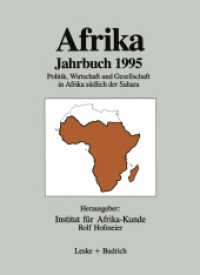- ホーム
- > 洋書
- > 英文書
- > Science / Mathematics
Full Description
Peter Smith has joined forces with skilled consultants to take his piping series to the next level. The Planning Guide to Piping Design covers the entire process of planning a plant model project from conceptual to mechanical completion, and explains where the piping lead falls in the process along with his roles and responsibilities. Piping Engineering Leads (or PEL's) used to only receive on-the-job training to learn the operation of producing a process plant. Over time, more schools and programs have developed a more advanced curriculum for piping engineers and designers. However, younger generations of engineers and designers are growing up with a much more technological view of piping design and are in need of a handbook that will explain the proven methods of planning and monitoring the piping design in step-by-step processes. This handbook will provide mentors in the process piping industries the bridge needed for the upcoming engineer and designer to grasp the requirements of piping supervision in the modern age.
Contents
ForewordPrefaceList of FiguresList of Tables1 Before You Begin1.1 Introduction1.2 Standards1.2.1 Standard Drawings1.2.2 Charts1.2.3 Drawing Templates and Drawing Standards1.2.4 Drawing Numbering1.2.5 3-D Model Numbering1.2.6 Material Commodity Codes1.3 Specifications1.3.1 Piping Classes1.4 Procedures1.4.1 Stick Files1.4.2 Inter-discipline Drawing Reviews1.4.3 Line Numbering1.4.4 Stress Analysis1.4.5 CAD Set-up1.4.6 3-D Model Reviews1.4.7 Checking1.4.8 Manhour Estimating1.4.9 Progress Reporting1.4.10 Management of Change1.4.11 As-Builting1.4.12 Project Close-out1.5 Piping Execution Plan1.5.1 Design Basis Memorandum (DBM)1.5.2 Project Execution Plan (PEP)1.5.3 Contracting and Procurement Plan and Construction Execution Plan1.6 Conclusion2 Procedures2.1 Introduction2.2 Master Stick Files, Working Copies, and Inter-Discipline Drawing Reviews (IDR)2.2.1 Master Stick Files2.2.2 Working Copies2.2.3 Inter-Discipline Drawing Reviews2.3 Vendor Drawing Reviews2.4 Line Numbering2.4.1 Line Numbering Rules2.5 Stress Analysis2.5.1 The Stress Analysis Procedure2.5.2 Stress Analysis Procedure Notes2.6 Model Reviews2.6.1 Model Review Procedure2.6.2 Model Review Matrix2.7 Checking2.7.1 Clash Check Reporting Procedure2.7.2 Equipment Checking Procedure2.7.3 Piping Arrangement and Isometric Checking2.7.4 Prerequisites and Checking Procedure2.8 Manhour Estimating and Manpower Planning2.8.1 Manhour Estimating2.8.2 Manpower Planning2.8.3 Other Considerations3 Deliverables3.1 Introduction3.2 Deliverables3.2.1 Cover Sheets and Drawing Indexes3.2.2 Plot Plan3.2.3 Key Plans3.2.4 Location Plans3.2.5 Piping Arrangements3.2.6 Isometrics3.2.7 Isometric Logs3.2.8 Tie-in Isometrics3.2.9 Tie-in List3.2.10 Demolition Drawings3.2.11 Heat Tracing Circuit Layouts3.2.12 Heat Tracing Logs3.2.13 3-D Models3.2.14 Model Indexes3.2.15 CWP Drawing Packages and Scopes of Work (SOW)3.2.16 Process Flow Diagrams (PFDs)3.2.17 Piping and Instrumentation Diagrams (P&IDs)3.2.18 Line Designation Tables (LDTs)4 Detailed Design4.1 Introduction4.2 Contracting and Procurement Plan and Construction Execution Plan4.3 Modularized and Field Erected Piping Splits and CWP Boundaries4.3.1 Notes to Figure 4-14.4 Model Boundaries4.4.1 Study Model Boundaries4.4.2 Detailed Model Boundaries4.5 Shop and Field Material Splits4.6 Procurement Splits4.7 Issued For Bid and Bid Evaluations4.7.1 Issued for Bid4.7.2 Clarifications from Bidders and Bid Evaluations4.8 Equipment Coordinates and Elevations4.9 Module Design4.9.1 Design Considerations4.10 Module Numbering4.11 Drafting Practice4.11.1 A Brief History4.11.2 3-D CAD Drafting Practice4.11.3 Ownership and Training4.11.4 Piping Arrangements4.11.5 Isometrics4.12 Holds4.13 Project Binders and Lists4.13.1 Project Binders4.13.2 Piping Job Notes and CAD Job Notes4.13.3 Action Item List and Needs List4.13.4 Equipment List4.13.5 Data Sheets4.14 Managing Standard Drawings4.15 Project Meetings4.16 Progress Monitoring4.17 Design Change Notice (DCN)4.18 Field Change Notice (FCN)4.19 Request For Information (RFI)5 Shop Fabrication5.1 Introduction5.2 Kick-off Meetings5.3 Scopes of Work (SOW)5.3.1 Example of Pipe Spool Fabrication Scope of Work5.3.2 Example of Module Fabrication and Assembly Scope of Work5.4 Instruction to the Fabricator5.4.1 Example of Instruction to Fabricator5.5 Requests For Information (RFI)5.6 Visits with the Fabricators5.6.1 The Value of Shop Visits5.6.2 Supporting the Fabricators5.7 Automatic Spool Generation5.8 Conclusion6 Field Construction6.1 Introduction6.2 Support from the Home Office6.2.1 Kick-off Meetings6.2.2 Field Erection of Piping Scope of Work6.2.3 Computers, 3-D Software Set-ups, and Maintenance6.2.4 Request for Information6.3 Support in the Field6.3.1 Utilizing the 3-D Models6.3.2 Problem Solving6.3.3 Punch Lists and Deficiency Reports6.3.4 Compiling and Submitting RFIs6.3.5 Investigating Back Charges and Extras6.3.6 Progress Monitoring6.3.7 Maintaining the Master Stick Files6.3.8 As-Builting6.4 Lessons Learned6.5 SafetyAbbreviationsIndex







